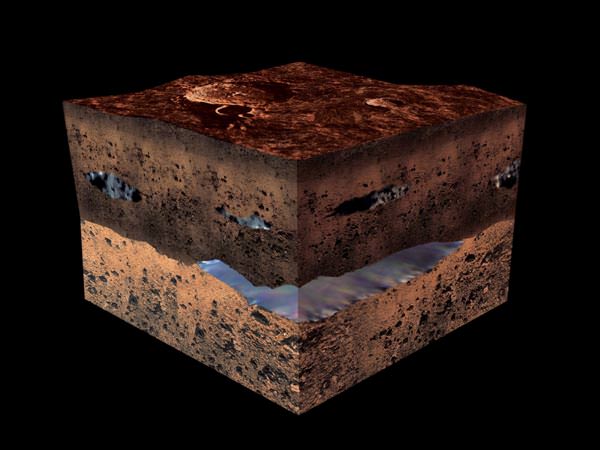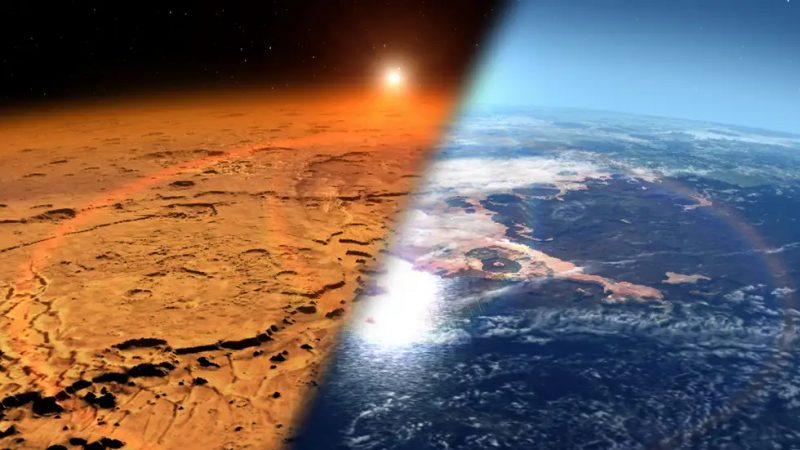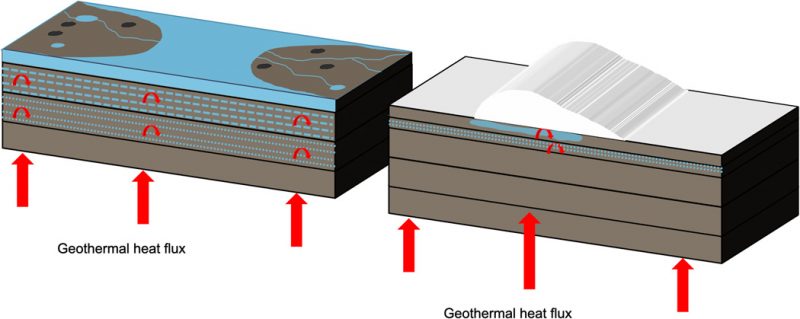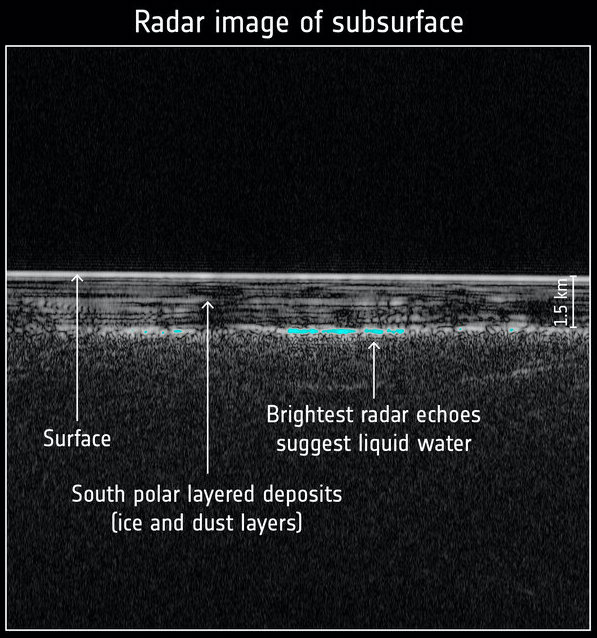

Cutaway illustration depicting subsurface lakes on Mars. Research suggests these underground lakes, or aquifers – formed by melting ice deep below the surface – would have been the best places for life to exist on a planet as cold as Mars. They might also help explain conflicting scenarios of a warm, wet early Mars versus the colder Mars we see today. Image via ESA/ Medialab.
If there was ever life on Mars, where would it be? What would be the best place to look for evidence of Martian life, whether that’s ancient fossilized life or still-living microbes? As many scientists have suggested, the answer may be underground, where conditions are warmer and may be wetter. Now, a new study – announced by Rutgers University in New Jersey on December 2, 2020 – expands on that idea. It suggests the region most likely to hold such evidence is several miles below Mars’ surface, where geothermal heat (geothermal energy) could have melted subsurface ice sheets.
The new peer-reviewed paper was published in Science Advances on December 2, 2020.
From the paper:
In explaining extensive evidence for past liquid water, the debate on whether Mars was primarily warm and wet or cold and arid 4 billion years (Ga) ago has continued for decades. The sun’s luminosity was ~30% lower 4 Ga ago; thus, most Martian climate models struggle to elevate the mean surface temperature past the melting point of water. Basal melting of ice sheets may help resolve that paradox. We modeled the thermophysical evolution of ice and estimate the geothermal heat flux required to produce meltwater on a cold, arid Mars. We then analyzed geophysical and geochemical data, showing that basal melting would have been feasible on Mars 4 Ga ago. If Mars were warm and wet 4 Ga ago, then the geothermal flux would have even sustained hydrothermal activity. Regardless of the actual nature of the ancient Martian climate, the subsurface would have been the most habitable region on Mars.
EarthSky 2021 lunar calendars now available! They make great gifts. Order now. Going fast!

Was early Mars always cold, with most of its water underground (left) or was it once warm and wet? The conflicting evidence for both still has not been resolved, but the new study may help to finally answer this long-standing question. Image via NASA/ Goddard Space Flight Center/ The Weather Channel.

Schematic representation of warm and wet early Mars (left) and cold, arid early Mars (right). Image via Ojha et al./ Science Advances.
The findings have direct implications for the possibility of life on Mars, past or present, and may also help scientists finally reconcile the two opposing scenarios of early Mars, whether it was warm and wet or colder and drier (or something in-between). As lead author Lujendra Ojha at Rutgers University-New Brunswick, stated:
Even if greenhouse gases like carbon dioxide and water vapor are pumped into the early Martian atmosphere in computer simulations, climate models still struggle to support a long-term warm and wet Mars. I and my co-authors propose that the faint young sun paradox may be reconciled, at least partly, if Mars had high geothermal heat in its past.
We know Mars was much wetter in the past, with lakes and rivers, and maybe even an ocean. But most climate models still suggest the planet was colder and drier than that. If Mars had enough heat underground, that could help explain the paradox, even if the planet was cold on the surface due to a fainter sun at the time, about 4 billion years ago.
Current evidence suggests that Mars had abundant liquid water on its surface 4.1 billion to 3.7 billion years ago (the Noachian era). In this new scenario, water could have been produced by melting ice below the surface, due to radioactive decay. Elements like uranium, thorium, and potassium are known to do that on rocky planets, including Earth. Even if the surface was colder, there could still have been enough heat deep below to melt the ice.

Lujendra Ojha at Rutgers University-New Brunswick, lead author of the new study. Image via Instagram.
This process would likely have been similar to subglacial lakes in areas of the West Antarctic Ice Sheet, the Canadian Arctic, and Greenland. Lake Vostok in Antarctica is a good example of one of these lakes. Drilling expeditions by Russian scientists in the dark subsurface lake have found microscopic life in the ice layers close to the liquid water. Further analysis has shown that Lake Vostok contains a diverse set of microbes, as well as some multicellular organisms.
So, could such heating have actually been possible during the Noachian era on Mars? The researchers say yes, saying that the conditions needed would have been ubiquitous.
After Mars lost its magnetic field and most of its atmosphere, it would have become impossible for liquid water to remain on the surface. But it could easily have persisted below the surface, at increasingly greater depths. Ojha said:
At such depths, life could have been sustained by hydrothermal (heating) activity and rock-water reactions. So, the subsurface may represent the longest-lived habitable environment on Mars.
If microbes ever existed on Mars on the surface or in the near-surface, they likely would have retreated deeper underground where liquid water was still available. It makes sense, then, that any traces of that life might be far below the surface, where they are protected from the harsh ultraviolet radiation of the sun.
The possibility of life in underground niches where water was or is available takes on extra significance with the discovery of what appear to be subsurface lakes on Mars right now. The first one was discovered by the Mars Express orbiter in 2018, beneath the south polar cap, with three more reported near it last October. These lakes, similar to ones in polar regions on Earth, are cold and probably very salty, but could still potentially support some kinds of microorganisms. The finding of any liquid water on Mars today is exciting in terms of possible life, since the surface is now so inhospitable.

Radar image from Mars Express in 2018 showing the first detected largest lake beneath the south polar ice. Similar subsurface lakes, created by melting ice, would have been the best places for Martian life to exist, according to the new study. Image via ESA/ NASA/ JPL/ ASI/ Univ. Rome/ R. Orosei et al. 2018.
The lakes beneath the south polar cap are probably kept liquid by salts, since there is little or no geothermal heat in this location. But could could there be others, perhaps in locations near volcanoes where there could still be some latent heat left over from when the planet was highly geologically active? And indeed, there is also now evidence for some volcanic activity still occurring below the Martian surface.
If any of these lakes are not too salty, they might be ideal habitats for microbes, just as the Rutgers researchers have hypothesized. Being able to sample them, however, is still far off in the future, unfortunately. But in the search for life, they might just be where future explorers strike biological gold.
Bottom line: A new study suggests that the best place to look for evidence of life on Mars is miles underground, where geothermal heat melted subsurface ice.
from EarthSky https://ift.tt/2WqTJkF


Cutaway illustration depicting subsurface lakes on Mars. Research suggests these underground lakes, or aquifers – formed by melting ice deep below the surface – would have been the best places for life to exist on a planet as cold as Mars. They might also help explain conflicting scenarios of a warm, wet early Mars versus the colder Mars we see today. Image via ESA/ Medialab.
If there was ever life on Mars, where would it be? What would be the best place to look for evidence of Martian life, whether that’s ancient fossilized life or still-living microbes? As many scientists have suggested, the answer may be underground, where conditions are warmer and may be wetter. Now, a new study – announced by Rutgers University in New Jersey on December 2, 2020 – expands on that idea. It suggests the region most likely to hold such evidence is several miles below Mars’ surface, where geothermal heat (geothermal energy) could have melted subsurface ice sheets.
The new peer-reviewed paper was published in Science Advances on December 2, 2020.
From the paper:
In explaining extensive evidence for past liquid water, the debate on whether Mars was primarily warm and wet or cold and arid 4 billion years (Ga) ago has continued for decades. The sun’s luminosity was ~30% lower 4 Ga ago; thus, most Martian climate models struggle to elevate the mean surface temperature past the melting point of water. Basal melting of ice sheets may help resolve that paradox. We modeled the thermophysical evolution of ice and estimate the geothermal heat flux required to produce meltwater on a cold, arid Mars. We then analyzed geophysical and geochemical data, showing that basal melting would have been feasible on Mars 4 Ga ago. If Mars were warm and wet 4 Ga ago, then the geothermal flux would have even sustained hydrothermal activity. Regardless of the actual nature of the ancient Martian climate, the subsurface would have been the most habitable region on Mars.
EarthSky 2021 lunar calendars now available! They make great gifts. Order now. Going fast!

Was early Mars always cold, with most of its water underground (left) or was it once warm and wet? The conflicting evidence for both still has not been resolved, but the new study may help to finally answer this long-standing question. Image via NASA/ Goddard Space Flight Center/ The Weather Channel.

Schematic representation of warm and wet early Mars (left) and cold, arid early Mars (right). Image via Ojha et al./ Science Advances.
The findings have direct implications for the possibility of life on Mars, past or present, and may also help scientists finally reconcile the two opposing scenarios of early Mars, whether it was warm and wet or colder and drier (or something in-between). As lead author Lujendra Ojha at Rutgers University-New Brunswick, stated:
Even if greenhouse gases like carbon dioxide and water vapor are pumped into the early Martian atmosphere in computer simulations, climate models still struggle to support a long-term warm and wet Mars. I and my co-authors propose that the faint young sun paradox may be reconciled, at least partly, if Mars had high geothermal heat in its past.
We know Mars was much wetter in the past, with lakes and rivers, and maybe even an ocean. But most climate models still suggest the planet was colder and drier than that. If Mars had enough heat underground, that could help explain the paradox, even if the planet was cold on the surface due to a fainter sun at the time, about 4 billion years ago.
Current evidence suggests that Mars had abundant liquid water on its surface 4.1 billion to 3.7 billion years ago (the Noachian era). In this new scenario, water could have been produced by melting ice below the surface, due to radioactive decay. Elements like uranium, thorium, and potassium are known to do that on rocky planets, including Earth. Even if the surface was colder, there could still have been enough heat deep below to melt the ice.

Lujendra Ojha at Rutgers University-New Brunswick, lead author of the new study. Image via Instagram.
This process would likely have been similar to subglacial lakes in areas of the West Antarctic Ice Sheet, the Canadian Arctic, and Greenland. Lake Vostok in Antarctica is a good example of one of these lakes. Drilling expeditions by Russian scientists in the dark subsurface lake have found microscopic life in the ice layers close to the liquid water. Further analysis has shown that Lake Vostok contains a diverse set of microbes, as well as some multicellular organisms.
So, could such heating have actually been possible during the Noachian era on Mars? The researchers say yes, saying that the conditions needed would have been ubiquitous.
After Mars lost its magnetic field and most of its atmosphere, it would have become impossible for liquid water to remain on the surface. But it could easily have persisted below the surface, at increasingly greater depths. Ojha said:
At such depths, life could have been sustained by hydrothermal (heating) activity and rock-water reactions. So, the subsurface may represent the longest-lived habitable environment on Mars.
If microbes ever existed on Mars on the surface or in the near-surface, they likely would have retreated deeper underground where liquid water was still available. It makes sense, then, that any traces of that life might be far below the surface, where they are protected from the harsh ultraviolet radiation of the sun.
The possibility of life in underground niches where water was or is available takes on extra significance with the discovery of what appear to be subsurface lakes on Mars right now. The first one was discovered by the Mars Express orbiter in 2018, beneath the south polar cap, with three more reported near it last October. These lakes, similar to ones in polar regions on Earth, are cold and probably very salty, but could still potentially support some kinds of microorganisms. The finding of any liquid water on Mars today is exciting in terms of possible life, since the surface is now so inhospitable.

Radar image from Mars Express in 2018 showing the first detected largest lake beneath the south polar ice. Similar subsurface lakes, created by melting ice, would have been the best places for Martian life to exist, according to the new study. Image via ESA/ NASA/ JPL/ ASI/ Univ. Rome/ R. Orosei et al. 2018.
The lakes beneath the south polar cap are probably kept liquid by salts, since there is little or no geothermal heat in this location. But could could there be others, perhaps in locations near volcanoes where there could still be some latent heat left over from when the planet was highly geologically active? And indeed, there is also now evidence for some volcanic activity still occurring below the Martian surface.
If any of these lakes are not too salty, they might be ideal habitats for microbes, just as the Rutgers researchers have hypothesized. Being able to sample them, however, is still far off in the future, unfortunately. But in the search for life, they might just be where future explorers strike biological gold.
Bottom line: A new study suggests that the best place to look for evidence of life on Mars is miles underground, where geothermal heat melted subsurface ice.
from EarthSky https://ift.tt/2WqTJkF

Aucun commentaire:
Enregistrer un commentaire